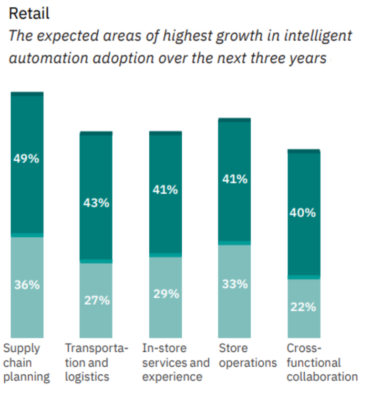The holiday shopping season is starting to resemble the movie Groundhog Day to retailers around the world. Increasing numbers of COVID-19 infections and hospitalizations are forcing governments to impose restrictions similar to the spring, creating new uncertainty about consumer spending.
Savvy retailers understand what it all means: Now more than ever they need to be in tune with market trends and bring agility to their supply chains. They must be able to accurately forecast product demand all the way down to product attributes at the individual store level. And they must be able to safely move people in and out of stores, deliver more things, more quickly through online shopping, and mitigate returns.
AI is helping many meet those challenges. Retailers are employing AI to provide safer contactless checkout lanes, which can also help reduce shrinkage in stores by at least 50 percent. Retailers are using AI to optimize merchandising and store layouts by understanding consumer demographics and behavior in stores, measuring crowd density and ensuring the health and safety of customers.
At the same time, with consumers shifting to online shopping, AI is helping retailers optimize the omni-channel experience by enabling customers to order online and pick up at curbside or have items delivered speedily to their homes.
Computer vision AI solutions recognize the model and color of cars to ensure the right order is delivered to the right customer at curbside pickup. And with AI for last-mile delivery, retailers can optimize truck routing based on constraints like the number of refrigerated trucks available. Today, reducing last-mile delivery costs by 40-50 percent is becoming a major undertaking.
“Retailers need to ensure their ecommerce capabilities are up to the task, with detailed visibility into demand changes and inventory — and a laser focus on seamless experiences and fulfillment efficiency,” wrote Brooks Kitchel, managing director of Accenture Strategy Retail, in its 14th annual holiday shopping survey.
NVIDIA has been working with retailers, as well as software startups that provide some of the most innovative AI technologies, to help them deploy AI solutions that can quickly be a boon to their bottom line.

At NVIDIA, based on our AI collaboration with the most innovative retailers and startups, we see three areas where AI is delivering the greatest business value:
1. Supply Chain Optimization:
AI-based forecasting is enabling retailers to run daily forecasting on millions of combinations of SKUs and stores, improving accuracy. For example, using NVIDIA RAPIDS software libraries and NVIDIA GPUs, Walmart has improved forecasting accuracy by 4 percent, resulting in hundreds of million dollars in cost savings, but most importantly ensuring the right product is available at the right stores or distribution centers at the right time for customers.
Intelligent warehouses powered by AI expedite distribution center throughput, improve order accuracy and accelerate order fulfillment. These solutions include intelligent multi-shuttle cabinets, adaptive speed conveyors and pick-and-pack robots that intelligently automate how items are unloaded from trucks, stored and retrieved for the right orders.
Hand-in-hand, these technologies remake the supply chain — everything from speeding and improving forecasting, to faster throughput in distribution centers, to robotic carts and arms for faster order fulfillment.
2. Ecommerce Optimization:
Recommender systems: Studies suggest that as much as 15 percent of an ecommerce site’s revenue is derived from delivering recommendations that are much more personalized based on a person’s interests and purchasing history. Stitch Fix, for instance, is using deep learning recommendation systems on NVIDIA GPUs to help stylists offer its 150 million active users more personalized styles from its existing inventory.
Other retailers are using deep learning recommendation systems optimized with the NVIDIA Merlin application framework to provide more personalization than before. Just a 1 percent improvement in the relevance of recommendations can translate into a big uptick in revenue.
Automated data labeling: Using computer vision, natural language processing and image recognition, startups such as Clarifai and CrowdAI use AI algorithms that learn from data scientists how to tag data and automatically generate meta-tagging to label and enrich data. Retailers can automatically label their ecommerce catalog at attribute level, which enables more personalized recommendations and helps customers find the right products on their ecommerce site.
Visual search: Computer vision technology has improved visual search, helping consumers find exactly what they’re looking for on ecommerce sites. This new type of search is for more than shopping. You can upload your own photos or select anything online to see similar photos and tags that describe the search engine’s notion of what’s in the picture. Once you select a lookalike image, you may see useful information like recipes, a location and more.
3. Intelligent Stores:
AI solutions that leverage computer vision are helping retailers bring intelligence to their retail stores.
Autonomous shopping: Frictionless checkout or intelligent “grab-and-go” stores use data from cameras and sensors to enable faster cashier-less checkout, which is becoming increasingly popular with the younger generation of shoppers. These applications enable retailers to redeploy workers to other areas, including fulfillment and curbside pickup.
Asset protection: The bane of retailers is shrinkage, which costs retailers 1.4 percent of annual revenue, according to the National Retail Federation. Retailers in the U.S. alone lose $63 billion nationally to shrinkage. AI is the only solution that can in real time detect ticket switching and mis-scans at every checkout lane, aisle and distribution center, saving retailers hundreds of millions of dollars across thousands of stores.
Stockout and curbside pickup: AI is also helping retailers eliminate stockouts by notifying associates when shelves have to be restocked and ensuring store associates deliver the right order to the right car at curbside pickup.
Exploring the Possibilities Through Partnerships
NVIDIA’s application frameworks, including Metropolis for video analytics, RAPIDS for data science, Riva for conversational AI and Merlin for ecommerce recommendation systems, are used by over 150 of the most innovative AI startups. Customers are also building their own AI solutions to improve the accuracy of their algorithms by accelerating training and optimizing compute performance.
Retailers can avoid the costly and time-consuming go-it-alone approach by adopting solutions provided by NVIDIA’s ecosystem of software partners and deploy AI in months instead of years. For example, software partners like Everseen and Malong are helping retailers reduce shrinkage by conducting 60-day proofs of concept, and then implementing across hundreds of stores. This has helped retailers reduce annual shrinkage by hundreds of millions of dollars per year.

These AI solutions aren’t just skunkworks technology projects for retailers. They’re driving profitability in an industry that has notoriously thin margins.
A good path forward for retailers is to first evaluate the overall AI solutions that would help them become more agile and efficient in meeting ever changing customer behavior, and then select one or two use cases that would deliver the greatest business value in the short term. We see most retailers starting with asset protection and AI-based forecasting.
Keep in mind that you don’t have to build everything from scratch if the cost justifies the buy versus build model. Consider working with startups and system integrators that already have proven solutions to enable you to deploy AI solutions quickly.
